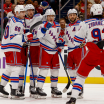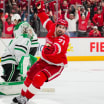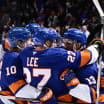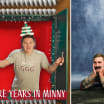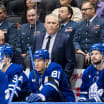Goalies make up 10 percent of an active NHL lineup but find themselves a lot less outnumbered in broadcast booths and TV studios around the League.
Half of the 32 NHL team broadcasts have a former NHL goalie working as a color commentator or studio analyst in either radio or television, and national broadcasts on each side of the border feature retired goalies like Henrik Lundqvist, Kelly Hrudey and Kevin Weekes.
All of which begs the question: What is it about having played the position that translates so well to explaining the entirety of a game to others?
Could it be as simple as the perspective from which a goalie sees the game, with almost everything happening in front of him?
“I think the point of view is a big part of it,” said Jamie McLennan, who played 254 NHL games with six teams during 18 seasons and now works as a studio analyst for TSN and as a color commentator between the benches on Ottawa Senators television broadcasts. “It's about understanding what could be coming at you, and especially with the speed and the game now, a lot of it is instinct. I used to try to learn all the systems and everything to understand how I could read plays coming toward me. Even when I was on the bench, it was all about mental imagery and envisioning myself in the net.
“I think that's why you see a lot of goalies [transition] into analysts because if you're a student of the game, and a lot of goalies are, it's about understanding everything about the game, not just the position. Goaltending is about identifying risk and identifying your percentages on plays and a lot of being a hockey analyst is the same type of thing.”
The way a goalie sees the game is not dissimilar to catchers in baseball, so perhaps it’s not a coincidence that so many catchers go on to became analysts, managers and even pitching coaches. Much like a goalie, being good as a baseball catcher requires knowing what everyone else on the field in front of them is doing, or at the very least should be doing.
“We cover a lot of different areas of the team,” said Darren Pang, who played 150 games with the Chicago Blackhawks from 1984-89 and now works on their TV broadcasts, as well as for TNT on national broadcasts, and as an analyst for NHL Network. “I hated being on the bench, but when I was, I felt like I was a coach. I was always going to the forwards or the defensemen behind the bench, talking about something the goalie was doing, always trying to explain that to them. Coaches leaned on me for that as well. I once did an entire book on what was at that time the Norris Division: every stick blade, every stick model, every color of tape, every curve on every player because I was injured at the time, and I gave it to [coach] Mike Keenan and he kept it.”
That level of knowledge is especially important for goalies, who need to know what everyone else is supposed to be doing on the ice because they don’t get to dictate the play.
“You have zero control over anything that happens in front of you, so you scout the game and learn patterns to help you anticipate because you have to react to everything,” said Chris Mason, who played 317 NHL games with four teams during 16 seasons and now works as a color commentator for Nashville Predators broadcasts on Bally Sports South. “The more you can learn, the more knowledge you possess, the more pattern recognition you have, it helps you anticipate plays and slows the game down. It gives you a mental advantage.”
Goaltending is so different from any other position in hockey and yet relies so heavily on each of them, so goalies have to understand what forwards and defensemen do in different systems, as well as preferences on the penalty kill and a variety of opposing power-play systems.
“It's an individual position in a team sport, and when you grow up playing goal you are in all the meetings and you have to have knowledge of what the other position mindsets are,” Mason said. “You’re always communicating with your defensemen, and you scout other teams to understand tendencies of how offensive players think to try to combat what they're going to do.”
Mason got a head start on his current job while backing up with the Predators when he was asked to put on a headset from the bench during third periods and talk to the television broadcasters, but he thinks his time as an NHL backup also prepared him for the job. It may not be a coincidence a lot of the ex-goalies now working with a microphone spent good chunks of their playing days as backups.
In some cases, it’s the vantage point. In others, it’s the personality required.
“You have to be a bit of a character,” Mason said. “Goalies don't feel the need necessarily to be cliche. Goalies have awesome ways to express yourself through your gear, through your mask. There's more personality there. I know there's a ton of NHL players that have that too, but you're going to find some pretty good characters per capita in the goalie community.”
Don’t assume that means those former goalies are always going to look for excuses for their peers that are still playing. McLennan may describe himself as a “goalie hugger” on the air sometimes, but Brian Hayward, who played 357 NHL games during 11 seasons and now is an analyst for Anaheim Ducks broadcasts, is careful not to be a goalie apologist.
“I'm probably harder on goaltenders than most,” Hayward said. “There are instances where they had no chance whatsoever, but I still believe you can play any situation differently and make a stop."
Whether it’s to forgive a goalie or hold them accountable, McLennan, Hayward and others pride themselves on being able to explain why a goal happened, including the play preceding the final shot.
Their experiences as goalies put them in a unique position to do it well.









